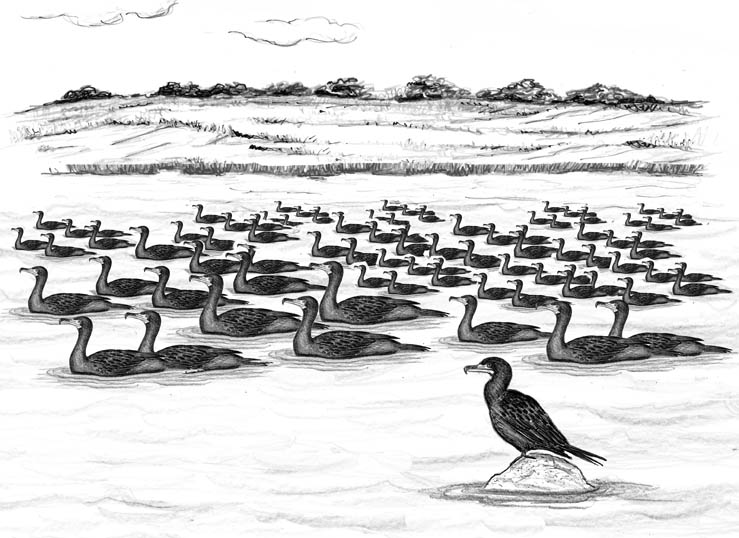
Dear Bird Folks,
I was driving on Rt. 28 in Chatham today when I noticed several cars pulled over. I thought people were taking photos of Pleasant Bay, but then I spotted a massive flock of birds in the water. So, I got out of the car and took a photo myself. Can you tell me what they are? I’m from the Berkshires and not familiar with saltwater birds.
– Paul, Otis, MA
I know Otis, Paul,
A few years ago I was exploring the back roads of the Berkshires (which is another way of saying I was lost) when I came upon the Otis Poultry Farm. Needing directions and a snack, I decided to stop in and visit the chickens. Once inside I discovered that the only chickens were in potpies. Eew! What kind of barbaric place was this? I was just about to leave when I noticed they also had pies filled with blueberries, apples and peaches. This was different. After the nice lady at the counter gave me proper driving directions, I purchased several fruit pies. Now I was back on the right track, totally full, very sticky, and in desperate need of a napkin.
The birds in your photo are Double-crested Cormorants. Cormorants may not be well known in your area, but around here everybody knows them, and most aren’t thinking good thoughts. When it comes to disliked creatures, Double-crested Cormorants are right up there with skunks, ticks and Harvey Weinstein. Why are cormorants so disliked? Well, they eat fish and fishermen don’t like competition. Boaters also don’t like them because cormorants often roost on their expensive boats. And because cormorants aren’t housebroken, or in this case, boat-broken, the birds will occasionally use boats as their personal litter boxes (hence the term “poop deck”).
Here in the big town of Orleans, Double-crested Cormorants are routinely in the news due to their habit of roosting on power lines that cross over a local pond. Each evening hundreds of these large birds gather along the wires to spend the night, much to the dismay of the nearby homeowners. (I guess fish-scented guano doesn’t smell as pleasant as you might think.) Town officials have tried to chase the birds away using an assortment of scare tactics, including pyrotechnics, with zero success. The town has also asked the power company to move the lines away from the pond, and that might help. But it could also force the birds to simply move to another site, which would be much to the dismay of the homeowners in the new location. There is a lot of “dismay” associated with cormorants.
For many years, Double-crested Cormorants avoided Massachusetts, probably due to the constant persecution by the fishing industry. But then a few things happened that changed the cormorants’ fortune. Stricter laws protected the birds from indiscriminant killing, and DDT, the curse of many fish-eating birds, was banned. In addition, the Clean Water Act of 1972 helped to restore our lakes and waterways. The cleaner waters resulted in the production of more fish and thus more fish-eating birds. (Who would have thought there’d be a downside to clean water?) But what really put cormorants back on track were catfish. Yup, catfish.
Double-crested Cormorants spend their summers in the north and then head south for the winter. Winter can be tough on birds, especially on young birds that haven’t quite developed the needed hunting skills. As a result, many of the juvenile birds that migrate south each fall never make the return trip in the spring. But then humans did cormorants a major favor. What did we do? We (the Southern states) started constructing catfish farms (seriously) and it didn’t take long for the cormorants to find these farms, which were stuffed with baby catfish. Suddenly, even the inept young cormorants were able to find enough food to survive the winter. Of course, the fish farmers, who were now losing lots of fish, quickly joined the growing list of cormorant haters. They had to try something to keep the birds away from their catfish ponds. What did they try? They tried good old pyrotechnics, but that didn’t work. To which the people in Orleans said, “No kidding.”
Based on the large number of cormorants we see around here each summer, you might think they nested all over the Cape. In reality, we have very few breeding cormorants. Most of the birds we see “drying” themselves on rocks and jetties, roosting on power lines or decorating our poop decks are young, non-breeding birds. Double-crested Cormorants don’t breed until they are at least two years old. So, like many human adolescents, these young cormorants are only here in the summer to enjoy the beach, soak up some sun and do a little fishing (or perhaps too much fishing). And if you think we have a lot of cormorants in the summer, the fall is worse, much worse. As they travel south for the winter, cormorants gather in staging areas. I’m not sure if Cape Cod is a major staging area, but it sure seems to be. Like you, I’ve seen huge numbers of these birds in tight flocks, often in Pleasant Bay, where they preen, splash about, and pose for photos for curious passersby.
Double-crested Cormorants are spreading inland, Paul. Eventually, they might even be headed your way. So, if the next time you visit the Otis Poultry Farm and find Cormorant Pie à la Mode on the menu, you’ll know they’ve arrived.